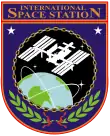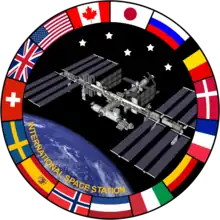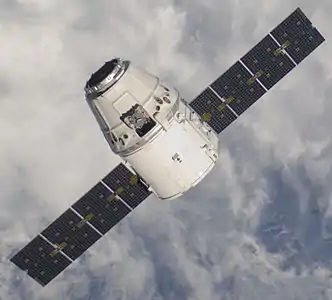SpaceX Crew-6
SpaceX Crew-6 is planned to be the sixth crewed operational NASA Commercial Crew flight of a Crew Dragon spacecraft, and the eleventh overall crewed orbital flight. The mission is planned for launch in early 2023. The Crew-6 mission would transport four crew members to the International Space Station (ISS). As of December 2021, two NASA astronauts have been assigned to the mission, with two more international astronauts to be named later. The two NASA astronauts are Stephen Bowen and Warren Hoburg.[1] However, continued international collaboration on ISS missions has been thrown into doubt by the 2022 Russian invasion of Ukraine and related sanctions on Russia.[2]
.jpg.webp) Artists' impression of a Crew Dragon approaching the forward port of Harmony on the ISS. | |
| Names | USCV-6 |
|---|---|
| Mission type | ISS crew transport |
| Operator | SpaceX |
| Mission duration | 180 days (planned) |
| Spacecraft properties | |
| Spacecraft type | Crew Dragon |
| Manufacturer | SpaceX |
| Launch mass | 12,519 kg (27,600 lb) |
| Landing mass | 9,616 kg (21,200 lb) |
| Crew | |
| Crew size | 4 |
| Members | |
| Start of mission | |
| Launch date | April 2023 (planned) |
| Rocket | Falcon 9 Block 5 |
| Launch site | Kennedy Space Center, LC-39A |
| Contractor | SpaceX |
| End of mission | |
| Landing date | Fall 2023 (planned) |
| Landing site | Atlantic Ocean |
| Orbital parameters | |
| Reference system | Geocentric orbit |
| Regime | Low Earth orbit |
| Inclination | 51.66° |
| Docking with ISS | |
| Docking port | Harmony forward |
| Undocking date | Q3 2023 (planned) |
| Time docked | 90–120 days (planned) |
Crew
Two crew members are yet to be announced. This includes the possible inclusion of a Russian cosmonaut who would be a part of the Soyuz-Dragon crew swap system of keeping at least one NASA astronaut and one cosmonaut on each of the crew rotation missions. This system would ensure that both countries have a presence on the station, and the ability to maintain their separate systems, if either Soyuz or commercial crew vehicles are grounded for an extended period.[3] On 24 March 2022 the European Space Agency announced that Danish astronaut Andreas Mogensen would serve as backup pilot.[4] On 29 April 2022, the Mohammed bin Rashid Space Centre (MBRSC) and Axiom Space announced that Crew-6 will also include an astronaut from the United Arab Emirates.[5]
MBRSC participation in this mission is a byproduct of a 2021 agreement between NASA and Axiom to fly a NASA astronaut, Mark T. Vande Hei, onboard Soyuz MS-18 (launch) and Soyuz MS-19 (return) in order to ensure a continuing American presence onboard the ISS. In return, Axiom received the rights to a NASA owned seat onboard SpaceX Crew-6. Axiom provided the flight opportunity to MBRSC professional crew member through an agreement with the United Arab Emirates Space Agency.[6]
| Position | Astronaut | |
|---|---|---|
| Spacecraft commander | Expedition 68/69 Fourth spaceflight | |
| Pilot | Expedition 68/69 First spaceflight | |
| Mission Specialist 1 | Expedition 68/69 TBA spaceflight | |
| Mission Specialist 2 | TBA Expedition 68/69 | |
| Position | Astronaut | |
|---|---|---|
| Spacecraft commander | ||
| Pilot | ||
| Mission Specialist 1 | TBA | |
| Mission Specialist 2 | TBA | |
Mission
The sixth SpaceX operational mission in the Commercial Crew Program is scheduled to launch in early 2023.
References
- Potter, Sean (16 December 2021). "Two Astronauts Receive Assignments for NASA's SpaceX Crew-6 Mission". NASA. Retrieved 17 December 2021.
 This article incorporates text from this source, which is in the public domain.
This article incorporates text from this source, which is in the public domain. - Witze, Alexandra (11 March 2022). "Russia's invasion of Ukraine is redrawing the geopolitics of space". Nature. doi:10.1038/d41586-022-00727-x. PMID 35277688. S2CID 247407886. Retrieved 13 March 2022.
- "Rogozin says Crew Dragon safe for Russian cosmonauts". SpaceNews. 26 October 2021. Retrieved 29 October 2021.
- https://twitter.com/esaspaceflight/status/1506922535010684929
- "Emirati astronaut set for six-month mission to International Space Station". 29 April 2022. Retrieved 29 April 2022.
- "Axiom Space and the Mohammed bin Rashid Space Center Sign Agreement for UAE Astronaut to Fly on the ISS in 2023". 29 April 2022. Retrieved 29 April 2022.



.jpg.webp)
